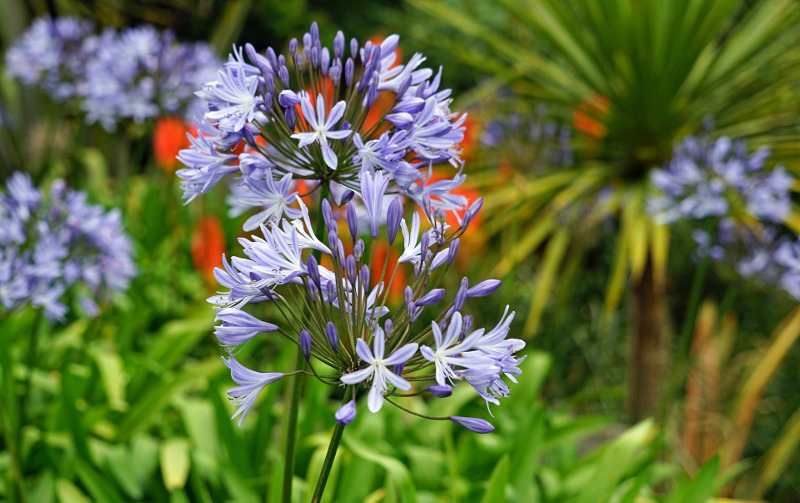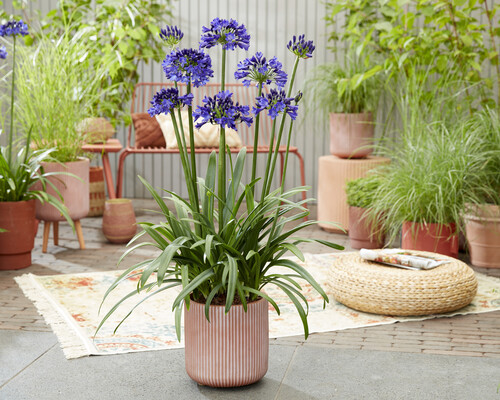Seasonal Agapanthus Care: Getting Ready For Wintertime and Summertime
Seasonal Agapanthus Care: Getting Ready For Wintertime and Summertime
Blog Article
Mastering the Art of Agapanthus Care: Important Steps for Healthy Growth and Vivid Blooms
In the realm of cultivation, the farming of agapanthus stands as a fulfilling undertaking for those that look for to nurture these classy blooming plants. From picking the ideal variety to mastering pruning strategies, the trip in the direction of cultivating thriving agapanthus plants is complex and holds the key to unlocking the full capacity of these organic treasures.

Picking the Right Agapanthus Selection

When selecting the right Agapanthus selection for your garden, take into consideration elements such as environment viability, blossom color, and development habit. Agapanthus, frequently recognized as Lily of the Nile or African lily, is available in a range of shades ranging from tones of blue and purple to white. Pick a blossom shade that matches your existing yard scheme to develop an unified landscape. Furthermore, take into consideration the climate in your area to guarantee the Agapanthus variety you pick can grow in your details problems. Some varieties are a lot more tolerant of cool temperatures, while others prefer warmer environments. Recognizing the growth behavior of different Agapanthus ranges is important for appropriate placement within your garden. Some selections have a clumping development behavior, suitable for containers or boundaries, while others have a more dispersing nature, ideal for ground cover or mass growings. By very carefully evaluating these elements, you can pick the excellent Agapanthus range to improve the appeal of your garden.
Ideal Planting Problems
Considering the ideal environmental demands is important for successful Agapanthus farming. Agapanthus thrives in well-draining soil with a somewhat acidic to neutral pH level. When planting, pick a location that gets full sunshine to partial shade. In hotter environments, giving some mid-day color can avoid scorching of the leaves. Agapanthus plants are delicate to cold temperatures and need to be secured from frost throughout cold weather.
To ensure healthy and balanced development and vivid flowers, plant Agapanthus bulbs at a deepness of concerning 2-4 inches and room them 8-12 inches apart. Including natural issue, such as garden compost, to the dirt can boost water drainage and fertility, advertising robust origin development. Mulching around the base of the plants assists preserve moisture and subdues weed development. Routine watering is important, specifically throughout the expanding season, to maintain the dirt regularly moist however not soaked.
Watering and Feeding Tips
Preserving proper moisture levels and offering important nutrients are crucial components in the treatment routine for Agapanthus plants. When it involves sprinkling Agapanthus, it is important to strike a balance. These plants favor continually wet soil however are at risk to root rot if overwatered. Throughout the expanding season, water deeply when a week, making certain the dirt is well-draining to protect against waterlogging. In hotter climates or throughout durations of drought, even more constant watering may be necessary to maintain the dirt uniformly moist. However, reduce watering in the winter season to prevent waterlogged conditions.
Fertilizing Agapanthus is important for advertising healthy and balanced growth and respected blossoms. Use a well balanced plant food, such as a 10-10-10 formula, in the very early spring as new development emerges. By adhering to these watering and fertilizing tips, you can ensure your Agapanthus plants thrive and create lively, resilient blooms.
Trimming Strategies for Agapanthus
Trimming Agapanthus plants at the suitable times and with appropriate methods is critical for preserving their health and promoting optimum development and blooming. The perfect time to prune Agapanthus is in late winter or very early spring prior to new development emerges. Begin by removing any kind of yellowing or dead fallen leaves near the base of the plant. Cut them as short as possible without damaging the emerging shoots.
For flowered stems, wait till the blossoms have actually perished and then trim them back to the base. This not only cleans up the plant's look yet explanation additionally motivates the advancement of new flower buds. Deadheading spent flowers can additionally redirect the plant's energy into producing more blooms instead than setting seeds. Nonetheless, if you wish to collect seeds for propagation, leave some blossoms to completely dry and fully grown on the plant.
Keep in mind to make use of tidy, sharp tools to make exact cuts and lower the threat of presenting conditions. Agapanthus. Regular pruning will certainly assist keep your Agapanthus looking cool and healthy while guaranteeing an abundant display screen of attractive blooms
Dealing With Typical Parasites and Conditions
After making certain appropriate pruning techniques for Agapanthus, it is vital to address usual insects and conditions that can affect the wellness and vitality anonymous of these plants. Agapanthus plants are usually durable but can still succumb to particular problems. One usual insect that influences Agapanthus is the Agapanthus gall midge. This tiny, orange fly lays its eggs in the foliage, resulting in distorted growth and blossom buds that fail to open up. To fight this parasite, trim and ruin any type of afflicted plant components and take into consideration using insecticidal soap.
Additionally, Agapanthus plants can experience from root rot if they are grown in improperly draining soil. By being watchful and taking prompt activity against bugs and conditions, you can assist your Agapanthus plants prosper and create vivid flowers. Agapanthus.

Final Thought
To conclude, mastering the art of agapanthus care entails choosing the best range, giving perfect growing conditions, proper watering and fertilizing, suitable trimming methods, and resolving common insects and diseases. By complying with these crucial steps, you can make certain Related Site healthy and balanced growth and vibrant flowers for your agapanthus plants. Remember to routinely keep track of and keep your plants to advertise their overall health and longevity.
To make sure healthy and balanced development and lively blooms, plant Agapanthus light bulbs at a depth of regarding 2-4 inches and room them 8-12 inches apart. By following these watering and fertilizing tips, you can guarantee your Agapanthus plants thrive and create lively, lasting flowers.
One common insect that affects Agapanthus is the Agapanthus gall midget. Additionally, Agapanthus plants can endure from root rot if they are planted in poorly draining dirt. By following these essential steps, you can guarantee healthy growth and vibrant blossoms for your agapanthus plants.
Report this page